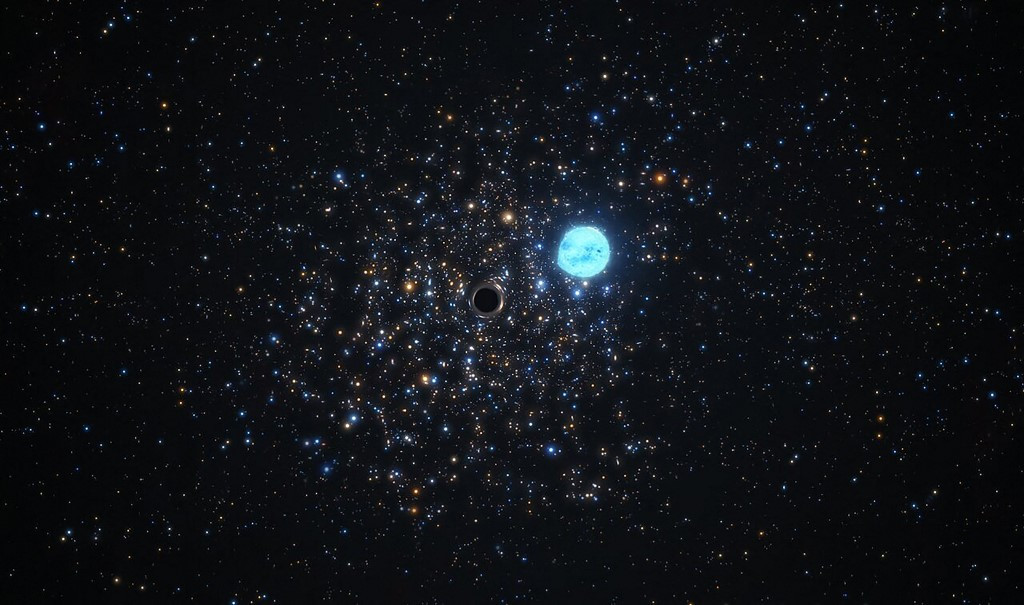Popular Reads
Top Results
Can't find what you're looking for?
View all search resultsPopular Reads
Top Results
Can't find what you're looking for?
View all search resultsAstronomers discover largest black hole in Milky Way
The black hole, named Gaia BH3, was discovered "by chance" from data collected by the European Space Agency's Gaia mission, an astronomer from the National Centre for Scientific Research (CNRS) at the Observatoire de Paris, Pasquale Panuzzo, told AFP.
Change text size
Gift Premium Articles
to Anyone
 This handout artist’s impression released on November 11, 2021, by the European Southern Observatory (ESO), shows a compact black hole 11 times as massive as the Sun and the five-solar-mass star orbiting it, located in NGC 1850, a cluster of thousands of stars roughly 160 000 light-years away in the Large Magellanic Cloud, a Milky Way neighbour. Astronomers have directly detected a black hole in a very young star cluster outside our galaxy for the first time, with a method promising new discoveries of these hard to pinpoint objects, according to a study released on November 11, 2021. The distortion of the star’s shape is due to the strong gravitational force exerted by the black hole. Not only does the black hole’s gravitational force distort the shape of the star, but it also influences its orbit. (AFP/Handout)
This handout artist’s impression released on November 11, 2021, by the European Southern Observatory (ESO), shows a compact black hole 11 times as massive as the Sun and the five-solar-mass star orbiting it, located in NGC 1850, a cluster of thousands of stars roughly 160 000 light-years away in the Large Magellanic Cloud, a Milky Way neighbour. Astronomers have directly detected a black hole in a very young star cluster outside our galaxy for the first time, with a method promising new discoveries of these hard to pinpoint objects, according to a study released on November 11, 2021. The distortion of the star’s shape is due to the strong gravitational force exerted by the black hole. Not only does the black hole’s gravitational force distort the shape of the star, but it also influences its orbit. (AFP/Handout)
A
stronomers identified the largest stellar black hole yet discovered in the Milky Way, with a mass 33 times that of the Sun, according to a study published on Tuesday.
The black hole, named Gaia BH3, was discovered "by chance" from data collected by the European Space Agency's Gaia mission, an astronomer from the National Centre for Scientific Research (CNRS) at the Observatoire de Paris, Pasquale Panuzzo, told AFP.
Gaia, which is dedicated to mapping the Milky Way galaxy, located BH3 2,000 light years away from Earth in the Aquila constellation.
As Gaia's telescope can give a precise position of stars in the sky, astronomers were able to characterise their orbits and measure the mass of the star's invisible companion -- 33 times that of the Sun.
Further observations from on-the-ground telescopes confirmed that it was a black hole with a mass far greater than the stellar black holes already in the Milky Way.
"No one was expecting to find a high-mass black hole lurking nearby, undetected so far. This is the kind of discovery you make once in your research life," Panuzzo said in a press release.
The stellar black hole was discovered when scientists spotted a "wobbling" motion on the companion star that was orbiting it.
"We could see a star a little smaller than the Sun (around 75 percent of its mass) and brighter, that revolved around an invisible companion," Panuzzo said.
Stellar black holes are created from the collapse of massive stars at the end of their lives and are smaller than supermassive black holes whose creation is still unknown.
Such giants have already been detected in distant galaxies via gravitational waves.
But "never in ours", said Panuzzo.
BH3 is a "dormant" black hole and is too far away from its companion star to strip it of its matter and therefore emits no X-rays -- making it difficult to detect.
Gaia's telescope identified the first two inactive black holes (Gaia BH1 and Gaia BH2) in the Milky Way.
Gaia has been operating 1.5 million kilometres from Earth for the past 10 years and in 2022 delivered a 3D map of the positions and motions of more than 1.8 billion stars.










